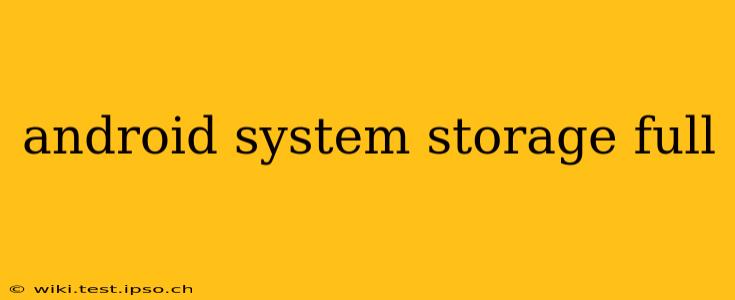Is your Android phone or tablet screaming "Storage Space Running Out?" That dreaded notification usually points to a full system storage partition, not just a lack of space for your apps and media. This is a frustrating problem, but thankfully, there are several ways to tackle it. This guide will walk you through the common causes and effective solutions to reclaim valuable storage space on your Android device.
Why is My Android System Storage Full?
Android's system storage isn't just for the operating system itself. It also houses crucial system files, cache data, log files, and temporary files generated by apps. Over time, these can accumulate, leading to a full system partition, even if you've deleted many apps and files. This can lead to performance issues, app crashes, and the inability to install updates.
What are the main culprits?
- System Cache: Your phone's cache stores temporary data to speed up apps. However, it can bloat over time.
- App Data: Apps often store temporary files, logs, and cached data, consuming significant space.
- Updates and Downloads: Incomplete downloads or failed system updates can occupy considerable space.
- System Logs: Detailed records of system activity can accumulate, consuming storage.
- Media Files: While not directly in system storage, very full device storage overall can indirectly impact the system partition.
How to Fix "Android System Storage Full"
Let's dive into practical solutions to free up that precious system storage.
1. Clear Cache Partition
This is usually the first and easiest step. Clearing the cache partition removes temporary files that don't affect your data or apps. The process varies slightly depending on your phone's manufacturer and Android version, but it generally involves booting into recovery mode. Consult your phone's manual or search online for instructions specific to your device model. This usually involves a combination of power and volume buttons.
2. Uninstall Unused Apps
Go through your apps list. Identify apps you haven't used in months and uninstall them. This frees up significant space, especially if you have large games or apps with extensive data.
3. Clear App Cache and Data
For apps you want to keep, individually clear their cache and data. This won't delete your app settings or user data, but it will remove temporary files and potentially reclaim a lot of space. You can find this option in your device's settings under Apps & Notifications > See all apps > [Select the app] > Storage & Cache.
4. Delete Downloaded Files
Check your downloads folder for any files you no longer need. This includes media files (videos, images), documents, and installation packages that are no longer relevant.
5. Remove Unused Widgets
Widgets on your home screen can sometimes consume unexpected storage. Remove any widgets that are no longer needed.
6. Use a Storage Management App
Several Android apps can help analyze your storage usage, identify large files, and offer automated cleanup options. These tools can pinpoint areas consuming excessive space that you might not have noticed manually. However, use caution and choose well-reviewed apps.
7. Move Media Files to an SD Card (If Applicable)
If your device supports external storage, you can move photos, videos, and music files to an SD card to free up space on the internal storage.
8. Factory Reset (Last Resort)
As a last resort, you can perform a factory reset. This completely wipes your device, restoring it to factory settings. This will erase all your data, so back up important files before proceeding. This is a drastic measure and should only be considered after exhausting other options.
How to Prevent System Storage from Filling Up Again
Prevention is better than cure. Here are some proactive steps:
- Regularly Clear Cache: Make this a part of your regular phone maintenance routine.
- Uninstall Unused Apps Frequently: Regularly review your app list and remove anything you don't need.
- Manage Downloads: Delete downloaded files promptly after you're done with them.
- Use Cloud Storage: Store important files on cloud services like Google Drive or Dropbox to free up internal storage.
By following these tips and troubleshooting steps, you should be able to resolve your Android system storage full issue and maintain a healthy and efficient device. Remember, consistent maintenance is key to avoiding this problem in the future.
